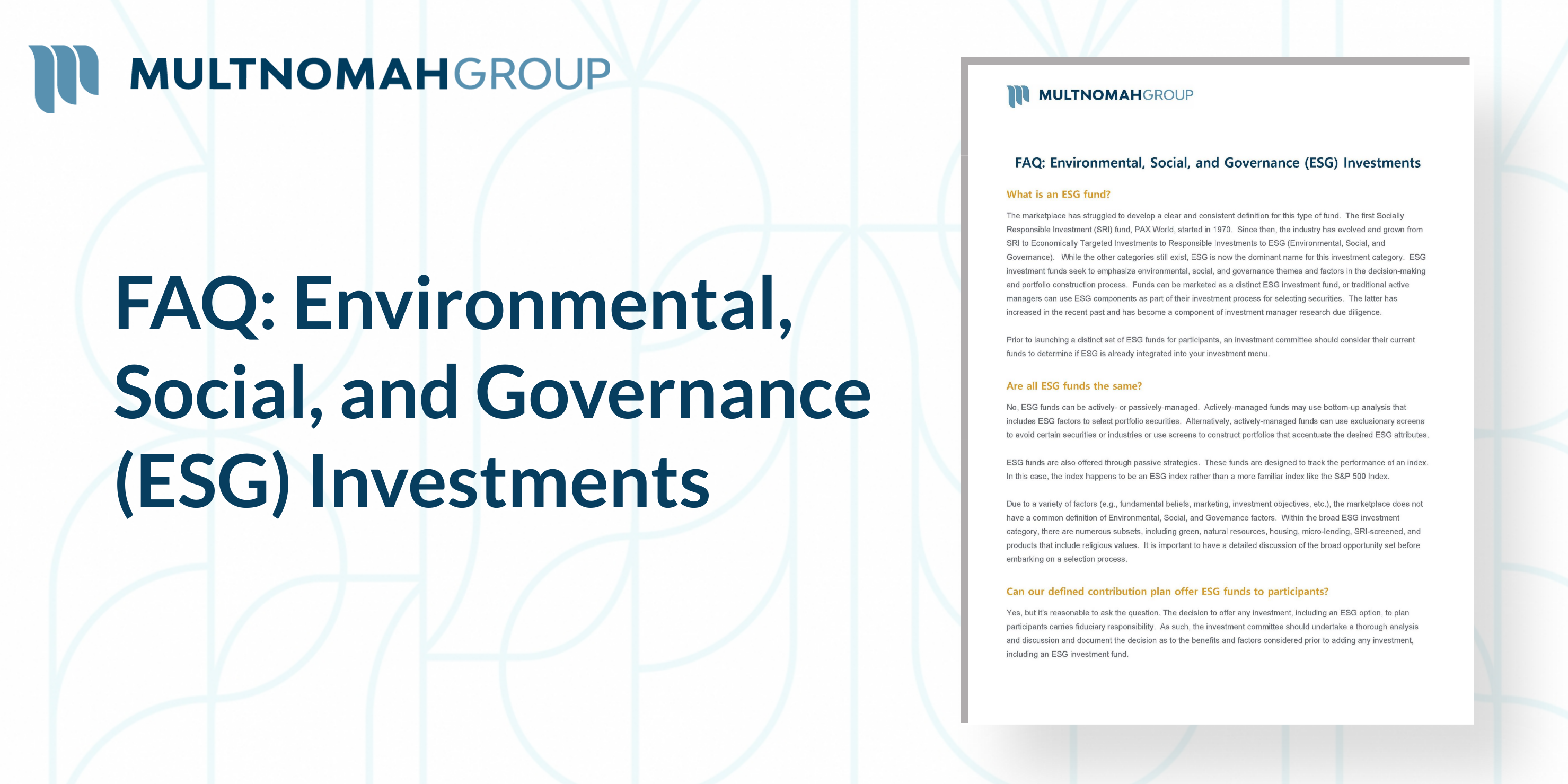In response to the growing number of questions surrounding Environmental, Social, and Governance (ESG) investments, we've pulled together a short FAQ to answer a few of the most common questions.
What is an ESG fund?
The marketplace has struggled to develop a clear and consistent definition for this type of fund. The first Socially Responsible Investment (SRI) fund, PAX World, started in 1970. Since then, the industry has evolved and grown from SRI to Economically Targeted Investments to Responsible Investments to ESG (Environmental, Social, and Governance). While the other categories still exist, ESG is now the dominant name for this investment category. ESG investment funds seek to emphasize environmental, social, and governance themes and factors in the decision-making and portfolio construction process. Funds can be marketed as a distinct ESG investment fund, or traditional active managers can use ESG components as part of their investment process for selecting securities. The latter has increased in the recent past and has become a component of investment manager research due diligence.
Prior to launching a distinct set of ESG funds for participants, an investment committee should consider their current funds to determine if ESG is already integrated into your investment menu.
Are all ESG funds the same?
No, ESG funds can be actively- or passively-managed. Actively-managed funds may use bottom-up analysis that includes ESG factors to select portfolio securities. Alternatively, actively-managed funds can use exclusionary screens to avoid certain securities or industries or use screens to construct portfolios that accentuate the desired ESG attributes.
ESG funds are also offered through passive strategies. These funds are designed to track the performance of an index. In this case, the index happens to be an ESG index rather than a more familiar index like the S&P 500 Index.
Due to a variety of factors (e.g., fundamental beliefs, marketing, investment objectives, etc.), the marketplace does not have a common definition of Environmental, Social, and Governance factors. Within the broad ESG investment category, there are numerous subsets, including green, natural resources, housing, micro-lending, SRI-screened, and products that include religious values. It is important to have a detailed discussion of the broad opportunity set before embarking on a selection process.
Can our defined contribution plan offer ESG funds to participants?
Yes, but it’s reasonable to ask the question. The decision to offer any investment, including an ESG option, to plan participants carries fiduciary responsibility. As such, the investment committee should undertake a thorough analysis and discussion and document the decision as to the benefits and factors considered prior to adding any investment, including an ESG investment fund.
How should our investment committee evaluate our ESG funds?
In our opinion, the selection criteria and ongoing monitoring factors should be defined in advance of adding an investment fund. We suggest that these items can be the same used for ESG and non-ESG funds alike. The criteria that we use are:
- investment style
- expenses
- experience
- diversification
- manager skill
- efficiency
- risk
How should ESG funds be communicated to participants?
Below is a sample investment menu that combines the concepts (described in our guide to investment menu construction) into a concise set of investments designed to meet participants ‘where they are.’ The investment menu provides a range of possibilities from multi-asset class single funds through style-specific active funds that seek to provide differentiated return patterns for participants wishing to express their specific investment views. The ESG specific funds build upon this concept through a fourth tier of investment options. The ESG tier covers the same broad asset classes of fixed income, U.S. equity, and international equity, but by emphasizing ESG themes in their portfolio construction. While frequently committees enjoy spending time on the investment selection and monitoring process, determining an investment choice architecture for the plan and its participants arguably, has a far more meaningful and long-lasting impact on retirement readiness.
What is the current guidance from the Department of Labor (DOL) regarding ESG funds?
The Trump Administration’s DOL issued a rule near the end of 2020, “Financial Factors in Selecting Plan Investments.” The rule focused on a plan sponsor’s ability to use Environmental, Social, and Governance (ESG) impacts in making investment decisions. The rule did not specifically mention ESG but stated that only ‘pecuniary factors’ could be used in making decisions related to investment options offered in a retirement plan. Pecuniary factors are defined as elements having a material impact on the risk and return of an investment. The rule also suggested that investments using social criteria or other non-pecuniary factors may not be appropriate as Qualified Default Investment Alternative (QDIA) investments.
In early 2021, the Biden Administration announced that this new rule would not be enforced. The DOL is taking a different tone from the previous administration by showing support for the role ESG integration can play in monitoring and selecting plan investments. This follows a history of changes in guidance on ESG investing coinciding with changes in administrations.

To download a PDF of this FAQ, click here.
Multnomah Group is a registered investment adviser, registered with the Securities and Exchange Commission. Any information contained herein or on Multnomah Group’s website is provided for educational purposes only and does not intend to make an offer or solicitation for the sale or purchase of any specific securities, investments, or investment strategies. Investments involve risk and, unless otherwise stated, are not guaranteed. Multnomah Group does not provide legal or tax advice. Any views expressed herein are those of the author(s) and not necessarily those of Multnomah Group or Multnomah Group’s clients.

